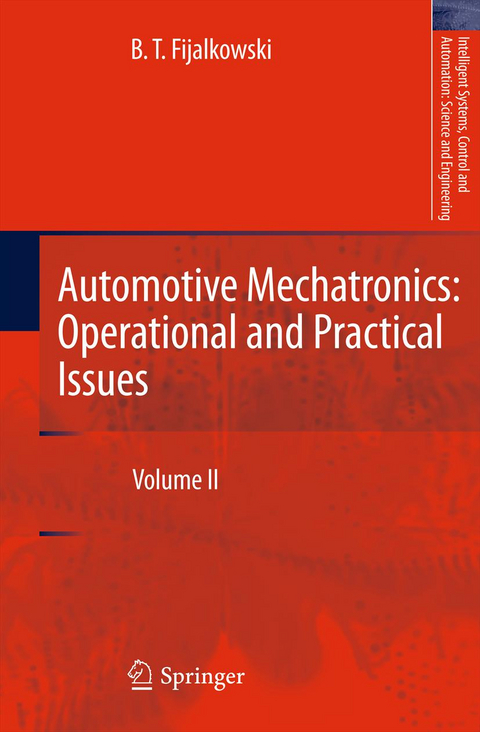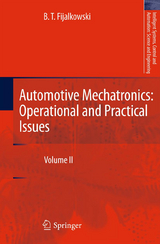Automotive Mechatronics: Operational and Practical Issues
This book presents operational and practical issues of automotive mechatronics with special emphasis on the heterogeneous automotive vehicle systems approach, and is intended as a graduate text as well as a reference for scientists and engineers involved in the design of automotive mechatronic control systems.
As the complexity of automotive vehicles increases, so does the dearth of high competence, multi-disciplined automotive scientists and engineers. This book provides a discussion into the type of mechatronic control systems found in modern vehicles and the skills required by automotive scientists and engineers working in this environment.
Divided into two volumes and five parts, Automotive Mechatronics aims at improving automotive mechatronics education and emphasises the training of students’ experimental hands-on abilities, stimulating and promoting experience among high education institutes and produce more automotive mechatronics and automation engineers.
The main subject that are treated are:
VOLUME I: RBW or XBW unibody or chassis-motion mechatronic control hypersystems; DBW AWD propulsion mechatronic control systems; BBW AWB dispulsion mechatronic control systems;
VOLUME II: SBW AWS conversion mechatronic control systems; ABW AWA suspension mechatronic control systems.
This volume was developed for undergraduate and postgraduate students as well as for professionals involved in all disciplines related to the design or research and development of automotive vehicle dynamics, powertrains, brakes, steering, and shock absorbers (dampers). Basic knowledge of college mathematics, college physics, and knowledge of the functionality of automotive vehicle basic propulsion, dispulsion, conversion and suspension systems is required.
Professor Dr B. T. Fijalkowski was born in Poland in 1932. He obtained MSc, PhD and DSc degrees in Electrical Engineering from Szczecin University of Technology in 1959, the Academy of Mining and Metallurgy in 1965 and Poznan University of Technology in 1988, respectively. He began his professional and electrical engineering career in 1955. He worked for 5 years in industry and 45 years in academia; he was the Director of the Electrotechnics & Industrial Electronics Institute, Faculty of Electrical and Computer Engineering and he was also the Head of Automotive Mechatronics Institution, Faculty of Mechanical Engineering at the Cracow University of Technology, Poland. He was a visiting professor at several well-known universities. He serves as Consultant to several organizations in Poland and the United States. He is co-founder of the World Electric Vehicles Association (WEVA). He was Guest Editor of Journal of Circuits, Systems and Computers - Special Issue on Automotive Electronics, Reviewer and Referee, IEEE Transactions on Circuits and Systems - Part I, and IEEE Transactions on Fuzzy Systems, USA. Reviewer of books and book chapters on "Automotive Electrics and Electronics", "Electric Drives Systems Dynamics" as well as 'Wireless Information Transmission", and is listed in 'Who's Who in the World", 'Who's Who in Science and Engineering" and so on. He has published 23 books and book chapters as well as over 187 technical papers and 25 patents on mining and automotive electrics and electronics as well as mechatronics. Recent publications by him include books (monographs), book chapters, journal articles, and conference proceedings on topics such as mathematical models of selected aerospace and automotive discrete dynamical hyper-systems as well as civil and military electric and hybrid-electric vehicles and also nano-magnetorheological fluid (NMRF) mechatronic commutator, 'crankless' internal combustion engines with energy storage, termed the Fijalkowski engines and automotive gas turbines that are based on the Fijalkowski turbine boosting (FTB) system. A great communicator, always candid and thoughtful in his interactions with others, he is an inspiration for many scientists. His hobby is yachting. He has the Rank of Ocean-Going Yacht Master.
PART 4.- 4 SBW AWS Conversion Mechatronic Control System.- 4.1 Introduction.- 4.2 Variable-Assist SBW 2WS Conversion Mechatronic Control Systems.- 4.2.1 Essentials of SBW 2WS Conversion Mechatronic Control Systems.- 4.2.2 Categories of the SBW 2WS Conversion Mechatronic Control Systems.- 4.2.3 Description of SBW 2WS Conversion Mechatronic Control Systems.- 4.2.4 Hybrid E-M-F-M EPFS SBW 2WS Conversion Mechatronic Control System.- 4.2.5 E-M EPS SBW 2WS Conversion Mechatronic Control System.- 4.3 Energy-Saving Effectiveness.- 4.3.1 Foreword.- 4.3.2 Tendency in Research and Development (R&D).- 4.4 Steer-By-Wire (SBW) Four-Wheel Steering (4WS) Conversion Mechatronic Control Systems..- 4.4.1 Foreword.- 4.4.2 Philosophy of SBW 4WS Conversion Mechatronic Control Systems.- 4.4.3 Dynamic Analysis of SBW 4WS Conversion Mechatronic Control Systems.- 4.4.4 Categories of SBW 4WS Conversion Mechatronic Control Systems.- 4.4.5 Foreword to Each SBW 4WS Conversion Mechatronic Control System.- 4.4.6 E-M SBW 4WS Conversion Mechatronic Control Systems.- 4.4.7 Tendency in Research and Development (R&D).- 4.5 Tri-Mode Hybrid SBW AWS Conversion Mechatronic Control Systems for Future Automotive Vehicles.- 4.5.1 Foreword.- 4.5.2 Philosophy of Tri-mode Hybrid SBW AWS Conversion Mechatronic Control.- 4.5.3 EM SBW AWS Conversion Actuators.- 4.5.4 SBW 4WS Conversion Mechatronic Control.- 4.5.5 Conclusion.- 4.6 SBW 4WS Conversion Mechatronic Control System for Automotive Vehicle Lane Keeping.- 4.6.1 Foreword.- 4.6.2 Automotive Vehicle Physical and Mathematical Models.- 4.6.3 SBW 4WS Conversion Mechatronic Control System Design.- 4.6.4 4WS Automotive Vehicle Lane-Keeping Simulation.- 4.6.5 Conclusion.- 4.7 Model-Based Design with Production Code Generation for SBW AWS Conversion Mechatronic Control System Development.- 4.7.1 Foreword.- 4.7.2 Model-Based Design with Production Code Generation.- 4.7.3 Behavioural Modelling.- 4.7.4 Simulation and Analysis.- 4.7.5 RapidPrototyping.- 4.7.6 Detailed Software Design.- 4.7.7 Physical Model Testing.- 4.7.8 Distributed Architecture Design.- 4.7.9 Production Code Generation.- 4.7.10 In-the-Loop Testing.- 4.7.11 Integration Components.- 4.7.12 Additional Resources.- 4.8 SBW AWS Conversion Mechatronic Control System Using Fault-Silent Units.- 4.8.1 Foreword.- 4.8.2 Time-Triggered Architectures for SBW AWS Conversion Mechatronic Control Systems.- 4.8.3 Structure of Possible Four-Wheel-Steered (4WS) Steer-By-Wire (SBW) Conversion Architecture.- 4.8.4 Conclusion.- 4.9 Discussion and Conclusions.- Glossary.- References and Bibliography.- PART 5.- 5 ABW AWA Suspension Mechatronic Control Systems.- 5.1 Introduction.- 5.2 Vehicular Suspension.- 5.2.1 Vehicular Suspension Categories.- 5.2.2 Vehicular Suspension Functions.- 5.2.3 Vehicular Suspension Performance.- 5.3 Passive Suspension.- 5.3.1 Foreword.- 5.3.2 Passive F-M or P-M Shock Absorber Suspension Mechatronic Control System.- 5.3.3 Passive F-P-M Suspension Mechatronic Control System.- 5.4 Self-Levelling Suspension.- 5.4.1 Foreword.- 5.4.2 Self-Levelling Suspension Mechatronic Control System Arrangement.- 5.4.3 Levelling Suspension Mechatronic Control System Components.- 5.4.4 Self-Levelling Suspension Mechatronic Control System Function.- 5.5 Semi-Active Suspensions.- 5.5.1 Foreword.- 5.5.2 Shock Absorber Suspension Mechatronic Control System Arrangement.- 5.5.3 Shock Absorber Suspension Mechatronic Control System Function.- 5.5.4 Types of Semi-Active Devices.- 5.5.5 Semi-Active ABW AWA Suspension Design Challenges.- 5.5.6 Semi-Active F-M ABW AWA Suspension Solution.- 5.5.7 Semi-Active P-M ABW AWA Suspension Solution.- 5.5.8 Semi-Active E-M ABW AWA Suspension Solution.- 5.5.9 Semi-Active MR ABW AWA Suspension Solution.- 5.5.10 Semi-Active ER ABW AWA Suspension Solution.- 5.5.11 Semi-Active PF ABW AWA Suspension Solution.- 5.6 Active Suspensions.- 5.6.1 Foreword.- 5.6.2 Active F-M ABW AWA Suspension Mechatronic Control Systems.- 5.6.3 Active F-P-M ABW AWA Suspension Mechatronic Control Systems.- 5.6.4 Active P-M ABW AWA Suspension Mechatronic Control Systems.- 5.6.5 Active E-M ABW AWA Suspension Mechatronic Control Systems.- 5.6.6 Active E-P-M ABW AWA Suspension Mechatronic Control Systems.- 5.6.7 Active E-M-M ABW AWA Suspension Mechatronic Control Systems.- 5.7 Hybrid ABW AWA Suspension Mechatronic Control Systems.- 5.8 Discussion and Conclusions.- Glossary.- References and Bibliography.- Acronyms.- Nomenclature.- Index.
| Erscheint lt. Verlag | 28.3.2011 |
|---|---|
| Reihe/Serie | Intelligent Systems, Control and Automation: Science and Engineering ; 52 |
| Zusatzinfo | XIV, 526 p. |
| Verlagsort | Dordrecht |
| Sprache | englisch |
| Maße | 155 x 235 mm |
| Themenwelt | Technik ► Elektrotechnik / Energietechnik |
| Technik ► Fahrzeugbau / Schiffbau | |
| Technik ► Maschinenbau | |
| ISBN-10 | 94-007-1182-4 / 9400711824 |
| ISBN-13 | 978-94-007-1182-2 / 9789400711822 |
| Zustand | Neuware |
| Haben Sie eine Frage zum Produkt? |
aus dem Bereich




